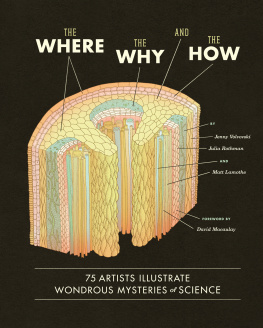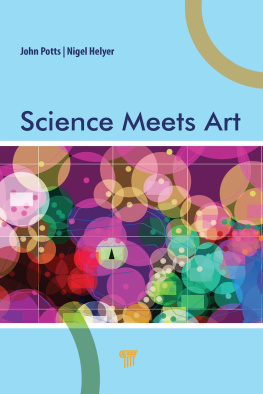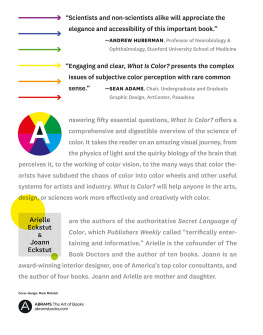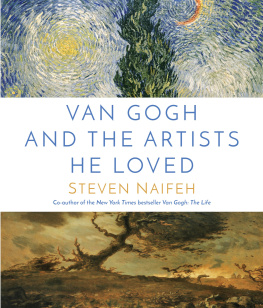
Today were spoiled with an abundance of information. We carry devices that fit in our pockets but contain the entirety of human knowledge. If you want to know anything, just Google it.

Driving in the car recently, the topic of conversation somehow steered to the question of why eggs are shaped like eggs. We all argued for a few minutes, each of us yelling over the other, about whether the shape has an evolutionary purpose. It only took a few minutes for someone to bring up Wikipedia on their phone and quickly dispel the mystery. The answer1 was read aloud to a hushed backseat. It was fascinating.
While we all learned something new, as soon as the answer was read, the discussion quickly quieted down. We all gave nods of agreement and the conversation moved on. The most fun, the period of wonder and funny guesses, was lost as soon as the 3G network kicked in.
Fortunately, there are still mysteries that cant be entirely explained in a few mouse clicks. With this book, we wanted to bring back a sense of the unknown that has been lost in the age of information. While scientists have figured out a great deal, much remains theoretical, and sometimes multiple opposing theories exist. Weve gathered together over 50 scientists from anthropologists to physicists, people studying viruses and others investigating the earths core. These scientists graciously agreed to be part of the project, and to explain the theories behind some of these unanswered questions.
Much of the inspiration for this book came from looking through old scientific charts and diagrams, in periods where the scientific world was still very much in early development. There are incredibly beautiful anatomically incorrect drawings from the Japanese Edo period, and wonderful classroom diagrams from the 1950s detailing the structure of blood cells. These visually unique works attempt to impart an understanding of a phenomenon in nature.
We invited 75 artists to make their own scientific illustrations or charts based on the questions posed by the scientists. Since these are all still mysteries, the artists could make their own explorations of the topic. We chose a mix of well-known and up-and-coming illustrators, comic artists, fine artists, and designers who we felt would be good at making informational artwork. After perusing their portfolios we matched the artist to the scientific question, trying to give each artist the question that matched best with their work, whether it required drawing dark matter or purring cats.
We hope by reading this book, youll learn some interesting things, but also enjoy reflecting on the mysteries themselves. Remember that before you do a quick online search for the purpose of the horned owls horns, you should give yourself some time to wonder.
WRITTEN BY
JENNY VOLVOVSKI.
JULIA ROTHMAN.
and MATT LAMOTHE
QUESTION / 1
WHAT EXISTED BEFORE THE BIG BANG?
I T IS SURPRISING, BUT TO CALL the beginning of the universe the Big Bang, current sciences shorthand name for that most distant past moment to which one can still trace the operation of our laws of physics, is a bit of a misnomer. Current evidence suggests that, far from being big, the whole vast expanse of space and all the visible galaxies and stars originated in a dense sphere of glowing gas much smaller than a pea. Some cosmologists, affecting a familiarity with events so far removed from our everyday experience, refer to the beginning now as just the Bang. General relativists, scientists who study physical consequences of Einsteins 1916 theory of relativity, chalk in hand, draw a horizontal line at the base of their blackboards and say: This is the singularity where it all started.
The era of the universe we now live in began about 14 billion years ago, when all that we can see today was compressed to a very high density and pressure, a plasma hotter than that in the core of a star. The observed elemental composition of the universe, especially the amount of helium present in it, is our best evidence for the first few seconds of the universes existence.
Another sign of the first fractions of a second of time after a beginning is the smoothness and uniformity of microwaves that fill the cosmos. The rules of Einsteins theory of general relativity deeply interconnect space and time to mass and energy. Matter can, in a sense, create the space it expands into and generate the time in which to do it. The universe was born in a state of very low entropy, which gives time its forward arrow and its enormous impetus to evolve. To see this, picture an alternative universe born into a state of high entropyimagine the universe as a lukewarm, uniform gas, evenly spread throughout a large box. Viewed day after day, the gas molecules in the box would be seen to bounce around, but the overall picture of a uniform gas in a box would remain unchanged, with no evolution of the overall temperature or distribution of the gas anywhere in the box. A low entropy state, on the other hand, is like a box which is empty (a vacuum) except for a concentrated ball of hot gas in one corner. This situation is not stable, and the ball of hot gas will expand quickly to fill the entire volume of the box, cooling as it goes. The analogy to the Big Bang early universe is similar, except that there is no empty box when the universe starts to expandinstead the mass-energy of the universe creates the space-time to expand into, as it evolves.
Was there an era before our own, out of which our current universe was born? Do the laws of physics, the dimensions of space-time, the strengths and types and asymmetries of natures forces and particles, and the potential for life have to be as we observe them, or is there a branching multi-verse of earlier and later epochs filled with unimaginably exotic realms? We do not know.
WRITTEN BY
BRIAN YANNY PhD
Research Scientist
Fermi National Accelerator Laboratory
ILLUSTRATED BY
JOSH COCHRAN
www.joshcochran.net

WHAT EXISTED BEFORE THE BIG BANG?
QUESTION / 2
WHAT IS DARK MATTER?
A STRONOMERS CAN MAKE estimates of galaxy masses in many different ways. We can calculate how much mass explains the light from galaxies seen in telescopes. We can also measure the speeds of stars on the outer edges of galaxies. The faster these stars move, the more gravitational pull from the galaxy is necessary to keep the stars from escaping.
Unfortunately, these two measurements lead to different galaxy masses. The stars at a galaxys edge are moving so fast that the mass of luminous stars and gas alone cannot explain why the stars are still a part of the galaxy at all. Thanks to careful observations, we now know that dust, planets, and black holes cannot fully explain the presence of these fast-moving stars. To explain the gravity that keeps these stars in the galaxy, we theorize that there must be more mass, dark matter, that keeps the stars bound to the galaxies.
Light from the early universe reveals that dark matter must be completely different kinds of particles from the ones that make up us, the earth, and the sun. Could dark matter be an exotic new particle? The contrast in scales is thrilling: The vast majority of the enormous mass of the universe might be explained by yet-undetected, infinitesimal subatomic particles. Satellites, tabletop experiments, and linear colliders are searching now for the dark matter particle.











